|
Friday, Aug. 15
3:30 p.m.
DIRECTOR'S COFFEE BREAK - Atrium (NOTE LOCATION)
4 p.m.
Joint Experimental-Theoretical Physics Seminar - Auditorium (NOTE LOCATION)
Speakers: A. Savoy-Navarro, LPNHE, Université Pierre and Marie Curie
A. Askew, Florida State University
Title: Recent CDF and DZero Results (as part of the Hadron Collider Physics Summer School)
Monday, Aug. 18
PARTICLE ASTROPHYSICS SEMINARS WILL RESUME IN THE FALL
3:30 p.m.
DIRECTOR'S COFFEE BREAK - 2nd Flr X-Over
4 p.m.
All Experimenters' Meeting - Curia II
Click here for NALCAL,
a weekly calendar with links to additional information. |
Friday, Aug. 15
- Old fashioned ham & bean
- Philly style chicken
- BBQ ribs
- Smart cuisine: baked fish over rice
- Roasted veggie & provolone panini
- Assorted slice pizza
- Roasted pork loin w/raspberry sauce
Wilson Hall Cafe Menu |
|
Wednesday, Aug. 20
Lunch
- Shrimp & pasta salad
- Cherry turnovers
Thursday, Aug. 21
Dinner
- Fresh tomato, mozzarella cheese with a basil dressing
- Grilled lamb chops
- Mushroom risotto
- Lemon sorbet with summer fruits
Chez Leon Menu
Call x4598 to make your reservation. |
|
|
Fermilab employees create outreach opportunities
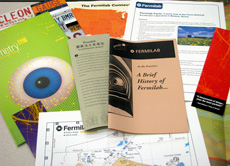
Fermilab handouts are available at the front desk in the Wilson Hall atrium and in the Office of Communication.
A little off-work initiative created a wealth of good will and new friends for Fermilab. Alex Chen of AD and Dave Harding of TD set up a table with information about Fermilab at a Warrenville neighborhood's annual picnic last month.
Even with a lighter than usual attendance and competition from a nearby reptile booth,
the effort paid off. Chen and Harding chatted with several local elected officials, and put a human face on the neighboring laboratory. In the Summerlakes Homeowners' Association newsletter, they earned a free thank-you advertisement for the Fermilab Science Adventure children's classes.
"In the end we probably talked with about two dozen people, not counting a
couple of Fermilab employees," Harding said. "People were interested in our funding situation and the future. Everyone expressed appreciation for our presence."
Some of the visitors to the table knew little about Fermilab; others had children in the Science Adventures program. Several had bicycled or fished at the laboratory but wanted to know more about the work done there.
The laboratory encourages such outreach. The Education Office has a variety of hands-on science activities, displays and literature that may be appropriate for such events. Harding also tapped into the Education Office to find a partner to help him man the booth. Nancy Lanning put Harding in contact with Chen, who is in the Education Office list of potential volunteers.
Chen got involved as a way to set an example for his children about giving back to the community, as well as a way to help promote the laboratory. At first he was a little worried that sitting at a booth would be boring or that people would ask questions he couldn't answer. Neither happened.
"It was very good," he said. "I met lots of interesting people. Some people knew a lot about the laboratory and others knew nothing. It was good to be there with David who knows a lot. Now I will be more confident the next time."
To meet with the Education Office contact Susan Dahl at sdahl@fnal.gov, x3094. Informational handouts about the laboratory also may be picked up in the Office of Communication.
--Tona Kunz
|
What is it?
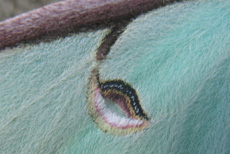
The design in this photo is actually the eyespot on the wing of a Luna moth. The moths, which are typically found at Fermilab both in May and July/August, have eyespots on their wings to confuse potential predators. Fermilab's own butterfly expert, Tom Peterson, sent in this photo, which was taken at the G2 service building on Aug. 14. Click on the image to see the entire moth.
|
STAR of the show
Without the need to connect remotely to Brookhaven National Laboratory (BNL) from all the way across the world to get analysis data, collaborating scientists in Prague can now do their analysis at lightning speed, thanks to their new local Tier2 site.
In an experiment called STAR, researchers aim to recreate the quark-gluon plasma (a soup-like state of the matter) that permeated the universe less than a second after the Big Bang. To do this, they analyze data from BNL's high-energy heavy nuclei collisions. Before installation of the Tier2 site at the Nuclear Physics Institute of the Academy of Sciences of the Czech Republic (NPI ASCR) in Prague, STAR collaborators had to connect to BNL remotely each time they needed to retrieve analysis data, and network latencies made this a tedious task.
For the Prague collaborators to analyze data more efficiently, the datasets from BNL needed to be brought onsite at NPI ASCR. With the new Tier2 site, NPI ASCR now has 20 terabytes of space to store these datasets, which can be rotated periodically depending on the researchers' demands and interests.
Read more
--Amelia Williamson, iSGTW
|
Dark-matter simulation reveals lumpy haloes
From Physics World, Aug. 6, 2008
Cosmologists in the US and Switzerland have made the most detailed simulation yet of how gravitational interactions have led to the "haloes" of dark matter we see near the centres of galaxies today. The feat could help future experiments grasp the nature of the dark matter, an elusive substance thought to make up nearly a quarter of the universe.
The simulation, which took over a month to run on a supercomputer, charts the evolution of over a billion dark-matter particles since a few million years after the Big Bang. It reveals that the dark-matter haloes are less smooth than previously thought.
"This is the best resolved calculation of the Milky Way's halo ever carried out, with a mass resolution five to sixty times better than the previous largest computations," explains Piero Madau at the University of California, Santa Cruz. "Previously, the inner regions of the halo came out smooth but now we have enough detail to see dense clumps of dark matter."
Read more
|
|
|
Pion-antipion collider physics at Fermilab
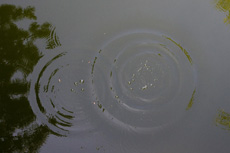
The direct decay and rescattering process of neutral kaons produces an interference pattern, like the one that forms when ripples from one rock dropped into water meet the ripples from another.
While physicists have studied proton-antiproton collisions for decades, they have never studied collisions between pions and antipions because colliding pion beams do not exist. New results from the KTeV experiment, which last took data in 1999, provide a look at what happens when a pion meets its antiparticle. Theorists have predicted the interaction probability for colliding pions, but experimental verification has been difficult.
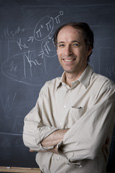 |
| Rick Kessler, University of Chicago senior research associate, performed this analysis. |
The decay of a K meson to three pions, K→ 3π, offers a unique laboratory to study pion interactions. The KTeV experiment at Fermilab has been used to study the decay of neutral kaons, K0→ π+π-π0, in which π+ and π- interact to produce π0π0 in a final state "rescattering" process that produces three neutral pions. This two-step process has the experimental signature K0→ π0π0π0, the same signature as the more common "direct" decay of the K0 into three neutral pions. The direct decay occurs about 50 times more frequently than the two-step π+π- rescattering process, thus requiring high precision to untangle the two effects.
The direct decay and rescattering processes produce a quantum interference pattern, like the interference pattern that forms when ripples from one rock dropped into the water meet the ripples from another. Think of the common direct decay as a large rock and the rare π+π- to π0π0 rescattering as a pebble, both dropped into the water. By studying the pattern formed when waves from the rock meet the waves from the pebble we can learn about the physical properties of the pebble. Similarly, when we study the quantum interference pattern between the two kaon decay processes, we extract the physical properties of the interactions of the pions in the two-step rescattering process. Just as a collider allows us to test the quantum chromodynamics, or QCD, that govern high-energy proton-antiproton collisions, the kaon decays allow us to test the QCD of low-energy pion-antipion interactions.
In a paper recently accepted by Physical Review D, the KTeV collaboration reported the observation of an interference pattern in a sample of 68 million K0→ π0π0π0 decays. The measured pion-antipion interaction rate agrees well with theoretical expectations and with results from the CERN NA48 experiment based on charged-kaon decays. Similar kinds of high-precision QCD measurements in K, B and D mesons might allow us to separate subtle QCD effects from the signatures of new physics in future experiments.
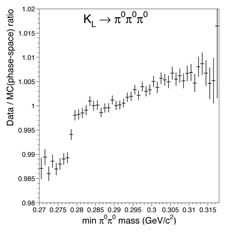
This graph shows the data-to-Monte Carlo ratio for the decay of a neutral K meson into three pions as a function of the minimum π0π0 mass (among three possible combinations). The K0→π0π0π0 Monte Carlo result is based on pure phase space calculations without physics effects. The rapid variation in the region around 0.28 GeV/c2 is from the interference between rescattering (π+π-→ π0π0) and direct decay. If there were no interference, this ratio would be a flat horizontal line. The theoretical prediction of the interference pattern agrees well with the observed shape.
|
|
The link to the survey in Thursday's Diversity story did not work. The error has been fixed and those interested in taking the survey can access it here.
|
|
Have a safe day!
Pool open additional weekends
The Fermilab pool will officially close at 6:30 p.m. Sunday, Aug. 17, but it will reopen for the weekends of Aug. 23-24, and Aug. 30-Sept. 1.
U.S. visa application changes
Applicants might experience longer-than-usual waits at U.S. Consulates during their visa application process. The Visa Office has reported that applicants have experienced waits for visas in excess of five weeks. While five weeks is unusual, it is a trend toward longer visa processing caused, in part, by security clearances.
Applicants for U.S. visas should make sure that they provide all the paperwork required for their visas. Check the U.S. Consulate's Web site prior to applying to find out what paperwork is required. Do not rely on past experience - processes change. Anyone whose visa application has been pending for four weeks should notify the Visa Office. Similarly, anyone contemplating applying for a U.S. visa abroad should contact the Visa Office prior to making travel plans. You also should advise the Travel Office of your visa application plans during the travel authorization process.
Change in retiree medical plan premium
Effective Oct. 1 the cost of the Fermilab retiree medical plan
will change. All retirees and employees will receive a letter with the
details of the changes. The information is also available online as a pdf
file. The Benefits Office will hold two meetings to answer questions regarding the
changes: Tuesday, Aug. 19, at 2 p.m. in Curia II, and Thursday, Sept. 11,
at 2 p.m. in One West.
Classifieds
Find new classified ads on Fermilab Today.
Additional Activities
|
|